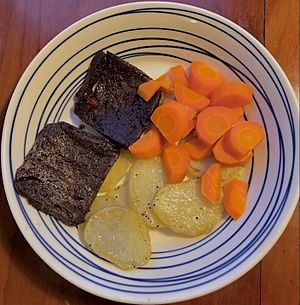Balkenbrij facts for kids
Balkenbrij is a traditional Dutch food. It's a bit like a thick, seasoned porridge. People in the Netherlands have made it for a long time. It was especially popular among farmers. They used it to make sure no part of a pig went to waste. This helped them save money. Balkenbrij is also known by other names like 'karboet' or 'pannas'. Similar foods are found in northwest Germany, like 'Panhas'.
How Balkenbrij is Made
Balkenbrij was often made on farms. This happened after pigs were prepared for food. People ate it quickly because it didn't stay fresh for long.
It is traditionally made from the liquid left over after making sausages. This liquid is boiled with flour. Sometimes blood is added, which makes the balkenbrij dark. Small pieces of bacon and organ meats are also used. These can include liver, kidney, or lungs. All these ingredients are cooked and then ground up.
Next, they are cooked again with more flour or oatmeal. A special mix of spices called "rommelkruid" is added. This spice mix includes things like liquorice, sugar, cinnamon, and ginger. Finally, the mixture is poured into a pan. It cools down to form a loaf. This loaf is then sliced into pieces about 1 centimeter thick. These slices are dusted with flour and fried. Traditionally, they were fried in lard.
Today, balkenbrij for stores is made with specific parts of the pig. These include blood, fat, and some muscle meat. Sometimes organ meats like liver are still used. Many German versions of this food use pearl barley.
Different Kinds of Balkenbrij
There are many different recipes for balkenbrij. Each Dutch region might have its own special way to make it. For example, the kind from Gelderland often has raisins in it.
Balkenbrij is related to a food called scrapple. Scrapple is popular in America. Some people also say balkenbrij is a distant relative of black pudding or Scottish haggis. However, balkenbrij does not use a casing, which is a key part of haggis.
Dutch settlers brought balkenbrij with them to the New World. An old cookbook from Holland, Michigan, even shared a recipe in 1936.


